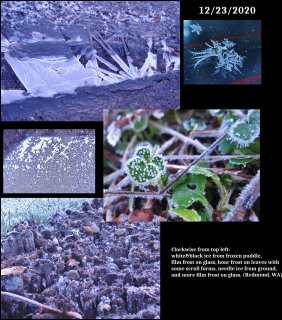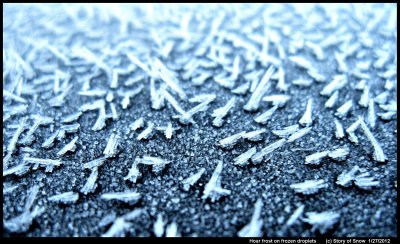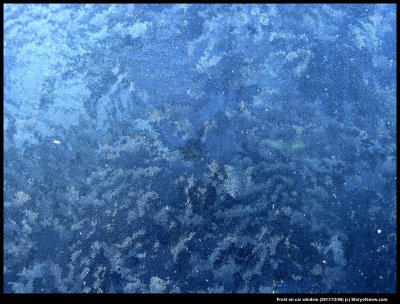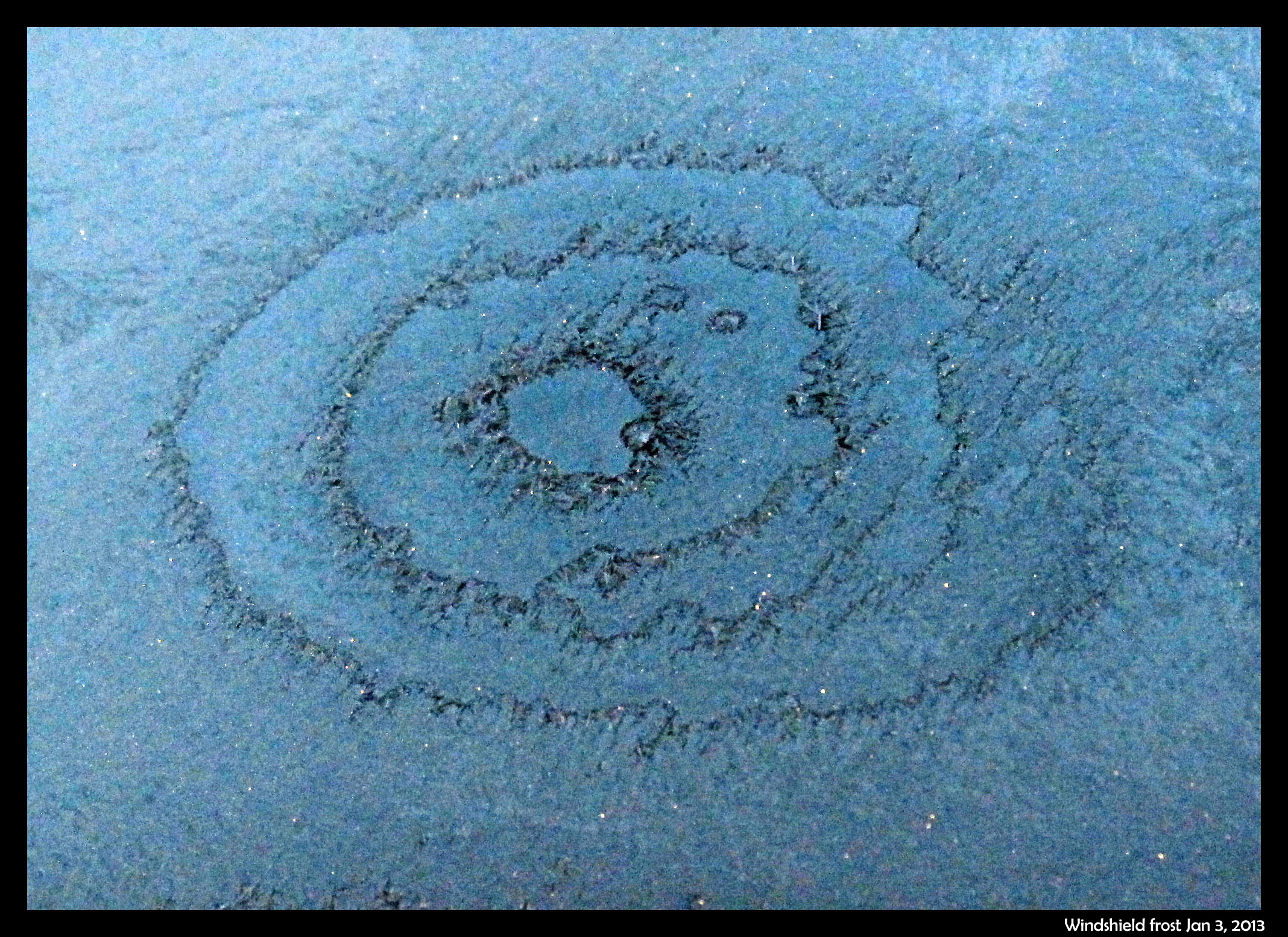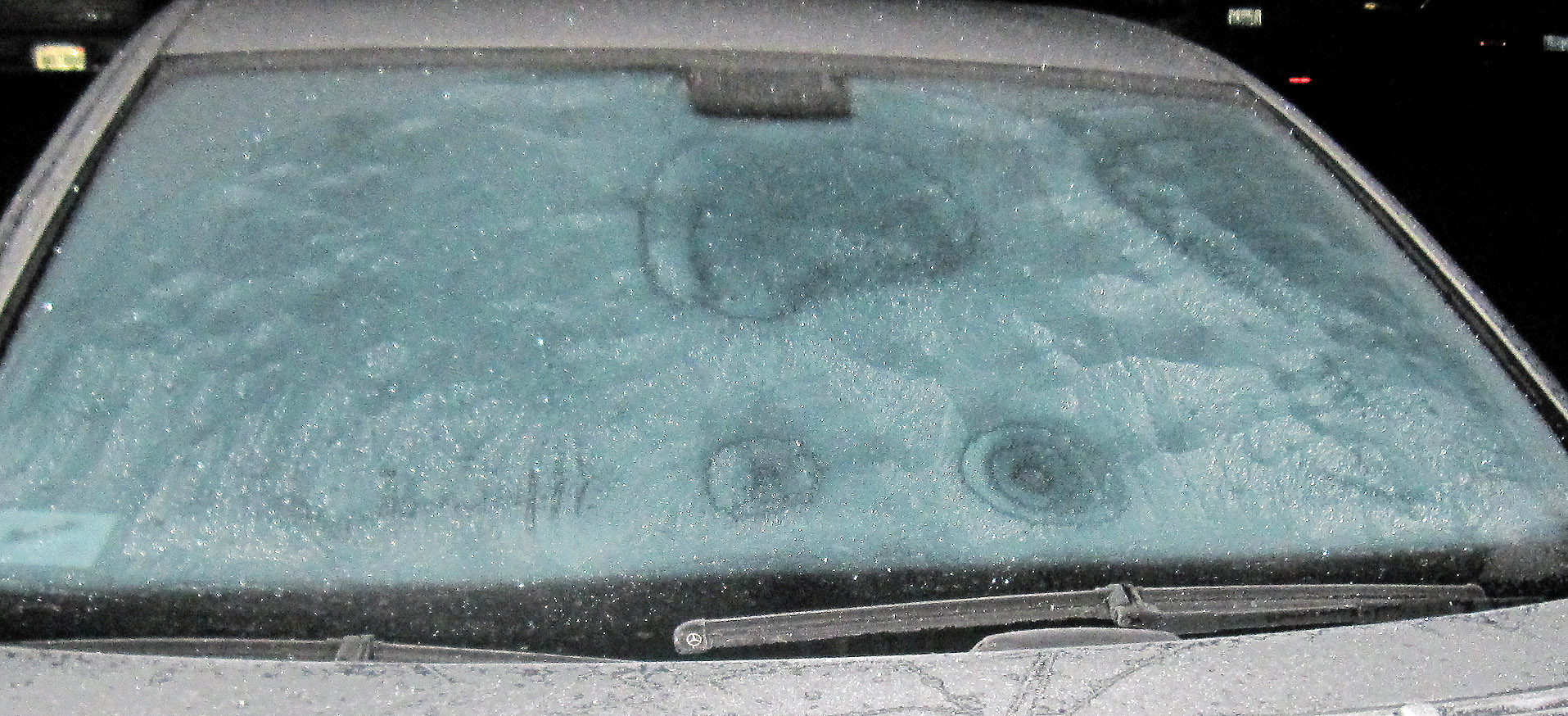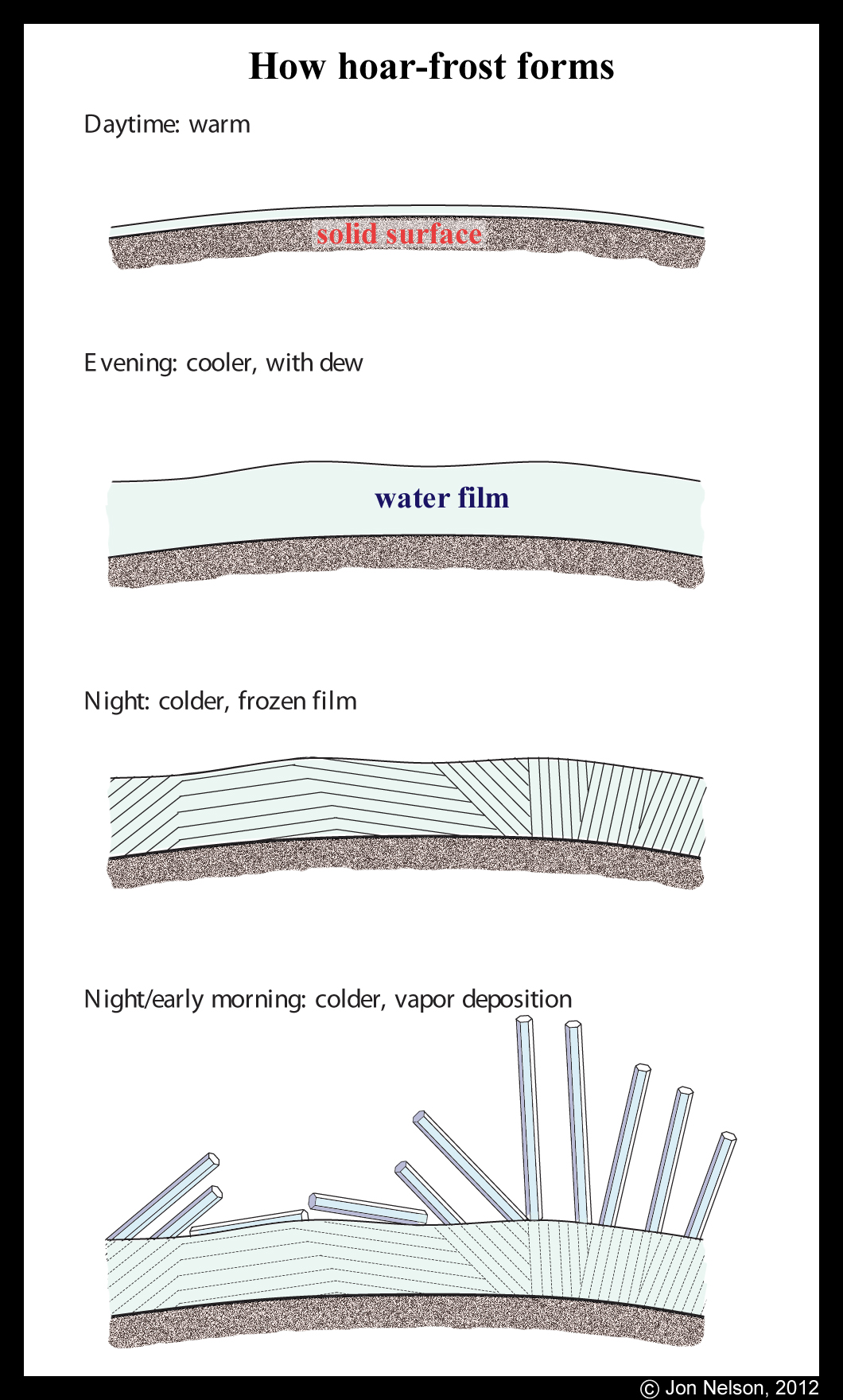Category: "Film frost"
Curved Film Frost, Part 1: On the General Causes
March 15th, 2022As I've seen it, the three most common ways to depict coldness in art and culture are the snow crystal, the icicle, and the curving frost on windows.
All of these have seen relatively little study, but without question the last has received the least. Indeed, I know of only three studies dedicated mainly to curving frost, and all three are over 50 years old.
It is perhaps little known that in terms of being observable to the typical observer, the third would likely be far more common. An odd thing to say? Well, people may say that they see it far less now due to the common use of central heating, or some might say that global warming is making it harder to form, but in these arguments they are wrong. I think the opposite: it is in fact far easier to see it now than maybe anytime in the past due to the ubiquitous presence of cars parked outdoors.
One curious thing about curved frost is its defining feature, the curviness. This feature contrasts with the straightness (and regularity) of snow crystals. What is the cause of the curviness in the former, as contrasts with the latter?
The Snowflake’s Closest of Kin
February 21st, 2022[From 2006 through 2012, I contributed annual articles to the annual newsletter "Snow Crystals" for the Wilson Bentley Historical Society. That newsletter is no longer available, so I will repost my articles here, starting with this one from 2006.]
Wilson Bentley is well known to readers here for his photomicrographs of snow crystals. Snow, however, was only one of the many ‘water wonders’ that held his fascination (ref. 1). Some of these wonders were made of liquid water, such as dew, and some, like the snow crystal, were frozen water (ice).
The frozen type he called “The snowflake’s closest of kin”, and they included hoarfrost, rime, windowpane frost, and ice flowers (2). To obtain photographs of any of them with the quality obtained by Bentley is difficult even now, which is yet another reason to admire Bentley’s skill and perseverance.
On the inside, these ‘kin’ all have the same crystal structure. But they appear different on the outside, largely due to the different ways the water in the surroundings gets to the ice surface. There are many distinct kin because the surrounding water can be in various states (i.e., ice, liquid, and vapor) and there are many ways that each state of water can get to the ice surface. I’ll focus here on snow crystals, hoarfrost, rime, windowpane frost, and ice flowers. These forms are commonly seen by many of us, and have been observed by people for a very long time. So it is easy to think, as I probably once did, that they are well understood by science. But this view is quite mistaken. Yes, we know they all consist of H2O molecules and we know something about the structure of ice, but how exactly they form contain many mysteries. I’ll describe briefly what Bentley thought of them, and what I think is known and not known about them.
A Stroll on a Mildly Frosty Morning
December 23rd, 2020So far this winter, we've had few frost days in the Redmond, WA area. This morning was typical of the half-dozen or so: a very light dusting of hoar crystals on the roofs and grass. One cannot expect much, and yet I am rarely disappointed. Indeed, it is not until I get close to some icy thing do I notice anything interesting. Sometimes, I still don't notice until I've clicked a few closeups and then viewed on a large computer screen. Here's what I found on this morning's stroll:
The frozen puddle showed some curvy meniscus lines and some straight ice blades, which I've discussed before. The film frost is more mysterious still, but the main curvy pattern is due to the freezing of melt (not vapor deposition, though some of this does occur). The hoar frost shows some scroll crystals, which I recently addressed in an article (no mechanism had previously been argued, but we propose an explanation). See the crystals on the leaf at upper right for the best examples of scrolls, though the details are yet a bit too small. The needle ice is the phenomenon responsible for the crunchy dirt and pushes ice up from the bottom. The ground is warmer below the surface, and here the liquid migrates to the ice front, pushing it all skyward.
Anyway, that's it for this post. No detailed explanations of anything. If you would like to see such explanations, click on the appropriate category in the archives at the right side.
And here's hoping you have a nice, frosty Christmas, wherever you are-
--JN
Hoar Frost on Plastic
February 17th, 2020The pattern of hoar frost depends on not just the current and prior conditions, but also on the surface. If the surface is less attractive to water, that is, more hydrophobic, then the hoar crystals tend to be more further spaced apart.
Or even more widely spaced apart. (Click on an image to enlarge it.)
These two images show hoar frost on plastic surfaces (garbage bin lids). If you look closely at the above picture, you will see that the hoar columns are growing off little mounds. These mounds are frozen droplets. You'll also notice that the directions of the ice columns are not random, but instead a given ice column tends to be pointing in nearly the same direction of its neighbors.
The Curious World of Ice and Snow: Part 2 of 3
February 8th, 2020As I mention in Part 1, these are slides I gave for a Science Cafe discussion session in 2012. This section focuses on ice that forms directly from the melt, that is, the liquid phase. Contrast these cases with those in part 1 in which the ice grew from the vapor. Some of these cases might seem a little familiar, but many ought to seem downright bizarre.
As always, click on an image to enlarge it.
The contents here are emphasized in green font below. The underlying difference between ice growth from vapor and from melt is that the melt is much denser. The higher density means that vastly more water molecules can impinge on the ice surface in a given time and area. This higher impingement usually means faster growth and larger crystals, but the way that the melt reaches the crystal influences the form, and the result is not always so obvious. In fact, I would even say that it is never obvious.
OK then, let's get right back into it.
Film frost grains and radiative cooling of the ground
December 10th, 2017December 8th brought the first frost to the Seattle area. This doesn't mean that this is the first time this season that the ground reached 0 degrees C or lower. True, we had gotten snow in late November, though this by itself doesn't mean the ground reached 0 C because snow deposition differs from frost formation. The snow was below zero when it formed in the air, but for the rest of its existence, it could have been melting and the ground itself likely sped up the process by remaining slightly above 0 C. But in contrast with the snow, for frost to form, the ground itself must cool below 0 C.
When I used to put out some metal plates with recording thermocouples, I didn't see visible frost until about -5 C, but that was based on just a handful of measurements. Anyway, what this means is that we may have had a few mornings with some patches of ground (including anything connected to the ground) dipping slightly below zero but with no obvious frost appearing. Also keep in mind that "ground temperatures" reported at weather stations are 1.5-2.0 meters above the ground, and thus may be 5-10 degrees C warmer at night than some ground patches. Why? At night, the ground cools by radiating, and if the atmosphere is not radiating much down, then considerable cooling happens. This is why clear nights are the ones with the most frost or dew.
Anyway, here is one shot of some of this "first frost" on my car window.
The image shows patches of different texture. These regions differ in texture because they are tiny hoar-frost (i.e., vapor-grown) crystals of differing size or orientation. That is, they stick up differently in different patches. They stick up differently because they sprouted off of a thin layer of film-frost that had a different crystal orientation. So, the patchy look comes from the different grains in the film-frost. See some of my previous posts with diagrams about this phenomena (category: "film frost"). Here is one with particularly helpful diagrams.
http://www.storyofsnow.com/blog1.php/choppy-waves
-- JN
Concentric Film Frost
October 25th, 2017October 16, 2017, the first frost of the 2017-18 winter as far as I know. Frost in Eastern Washington anyway, those of us on the west side of the Cascade Mts have not gotten any yet. Marc Fairbanks, an avid nature observer from the mountains near Cle Elum, sent me the following shot (click on the image to fully appreciate the pattern).
This is primarily film-frost, that is, is based on ice that formed when liquid film froze. But as I discussed in a previous post, some important growth processes here also occur through the vapor phase:
http://www.storyofsnow.com/blog1.php/crystal-to-crystal-communication-through-vapor-and-heat
I had even earlier noted some "ripple" patterns on a windshield and mused about their formation:
http://www.storyofsnow.com/blog1.php/ripples
As I'll discuss next, there are some other illuminating observations here.
More frost patterns on black cars
January 7th, 2017Black cars remain my favorite place to observe frost patterns. Here are a few I saw on one car today.
The straight lines of frost are more common when it is drier. And it has been quite dry here due to the very low temperatures.
These pictures show an interesting mixture of straight lines and curved boundaries.
And finally, the windshield had a pattern that resembled a hilly landscape.
But the pattern is actually quite flat. The frost is playing mind games on us, presenting an optical illusion of 3D topography.
As with all cases of frost on surfaces, the ice initially got started when a thin layer of liquid (melt) froze in various spots. The ice that grew, first grew in the melt layer, then grew on top, essentially "sucking"** the vapor out of the surrounding air, thus drying out surrounding regions. This is why we see bare surfaces near the larger frost crystals. Those frost crystals grew from the vapor, just like snow, but are anchored to the surface because that's where the film froze. So, two types of crystallization are important: freezing of the melt (melt --> ice) then vapor deposition (vapor --> ice).
- JN
** The actual process is diffusion (the way perfume molecules reach our noses), but this term is a little more vivid.
Crystal-to-crystal “communication” through vapor and heat
January 5th, 2013Two mornings ago, I saw this on the windshield of a parked car.
The bulls-eye pattern wasn’t centered on any particular feature on the windshield, and there were similar, though less developed, patterns nearby. See them on the photo below.
The dark parts are largely frost-free regions, and thus are regions that dried out during the crystallization event. (It was still dark when I took the shots.) Later, under a brighter sky, I saw a different pattern on the hood of another car, a pattern that I figure has a similar cause. In the hood case, shown below, the dry regions are bright due to reflection of the sky.
Now, about those concentric rings …
I puzzled over a larger such pattern in the Feb. 5, 2010 posting “Ripples”. The causative process that I proposed back then seems consistent with this newer observation, but I will clarify it here.
Before the first frost formed, the windshield, though seemingly dry, nevertheless had a thin layer of liquid water. This thin film had cooled to some temperature below freezing. (See the sketch “How hoar frost forms” in the Jan. 11, 2012 posting.) As the windshield and water film continued to cool, freezing was inevitable; the only issue was where. The first such spot to freeze must have had some feature, however minute, that was advantageous to freezing. It may have been a nucleant particle (e.g., a mineral dust grain, a type of bacteria, or even a tiny fleck of ice that wafted in from somewhere else), a slightly cooler spot, or a slightly thicker water film (e.g., from a scratch or indentation). But for whatever reason, the ice formed there first.
Now suppose the ice spreads outward from the nucleation spot in all directions with about the same rate. I suspect this happens when the film is extremely thin, as it would have been under the relatively dry conditions of this day. So, the frozen film grows outward, roughly as a disc. See the sketch below; the black dot in the center is the first place that froze.
Choppy waves
January 11th, 2012I thought this hoar frost pattern looked like rough seas. I see choppy, cusp-like waves down there.
Not having any pictures of rough seas, I hopped in our bathtub and kicked my legs around to make waves. Perhaps you can see a little resemblance.
However, the processes that caused the cusp-like, choppy wave pattern in the frost are completely different from those in the bathtub. Look more closely at the hoar-frost pattern:
It just goes to show you that hoar frost is never as simple as you’d think. Though from a distance it might look like white whiskers, up close it shows unexpected patterns. These patterns reveal something about how the crystals strained, twisted, and competed with each other.
Though it is true that the hoar crystals we see are built of deposited vapor molecules (invisible water molecules once floating in the air that happened to strike and freeze onto a cold surface), the story of hoar has an earlier beginning. In the beginning, the surface already had a thin film of liquid water. See the top panel in the sketch below.

